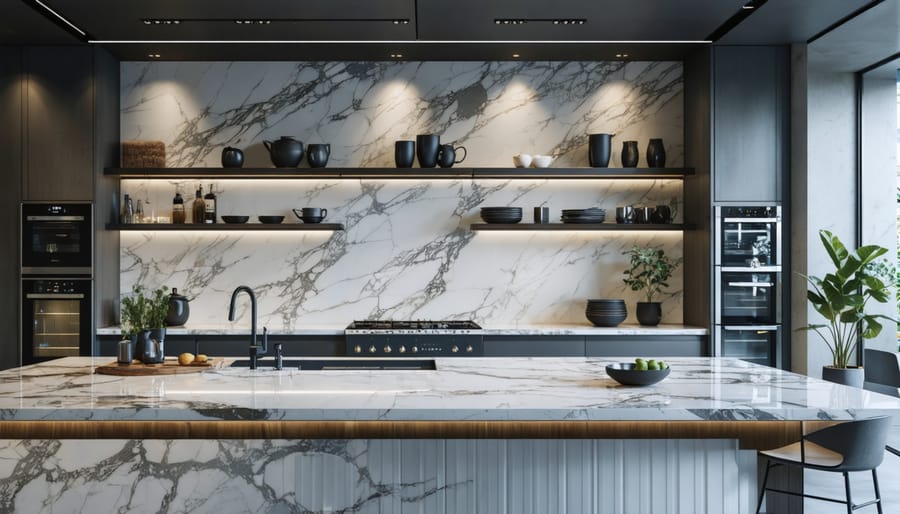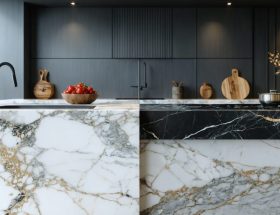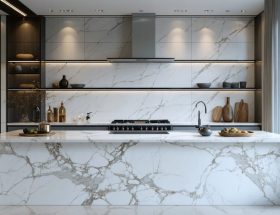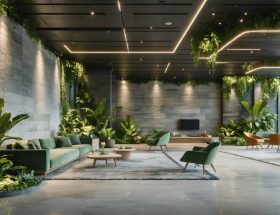Transform your kitchen’s aesthetic with quartz countertops, whose soaring popularity of quartz countertops stems from their remarkable versatility in colors and patterns. From classic marble-inspired veining to bold contemporary designs, quartz surfaces offer unparalleled design flexibility while maintaining superior durability and functionality.
Today’s engineered quartz countertops capture the depth and sophistication of natural stone while presenting an extensive palette ranging from pure whites and subtle grays to dramatic blacks and rich earth tones. Whether you’re seeking the timeless elegance of Carrara-inspired patterns or the clean, minimalist appeal of solid surfaces, modern manufacturing techniques create consistent, sophisticated appearances that complement any design aesthetic.
The beauty of quartz lies in its ability to combine stunning visuals with practical performance. Unlike natural stone, these engineered surfaces deliver predictable patterns and colors throughout every slab, ensuring your kitchen maintains a cohesive look while resisting stains, scratches, and daily wear. This perfect marriage of form and function has revolutionized kitchen design, offering homeowners the freedom to choose countertops that are both beautiful and intelligently engineered for modern living.
Popular Quartz Color Categories
Neutral Tones and Whites
Neutral-toned quartz countertops remain the most popular choice among homeowners and designers, offering timeless elegance and versatile design possibilities. Pure white quartz varieties like White Zeus and Arctic White provide a clean, modern aesthetic that brightens spaces and pairs beautifully with any cabinet color or backsplash material. These pristine options are particularly effective in smaller kitchens, where they create an illusion of expanded space.
Warm beige and cream variations, such as Fossil Taupe and Ivory Coast, bring subtle warmth while maintaining neutrality. These shades work exceptionally well in transitional and traditional kitchen designs, offering a softer alternative to stark whites. They’re especially complementary to wood cabinetry and natural stone floors.
Gray quartz options range from light pewter to deep charcoal, with popular choices including Concrete Gray and Storm Cloud. These sophisticated neutrals have gained traction in contemporary designs, offering industrial appeal without the maintenance concerns of actual concrete. Multi-toned gray variations often feature subtle veining or speckles, adding depth while maintaining a neutral palette that won’t overwhelm your space.
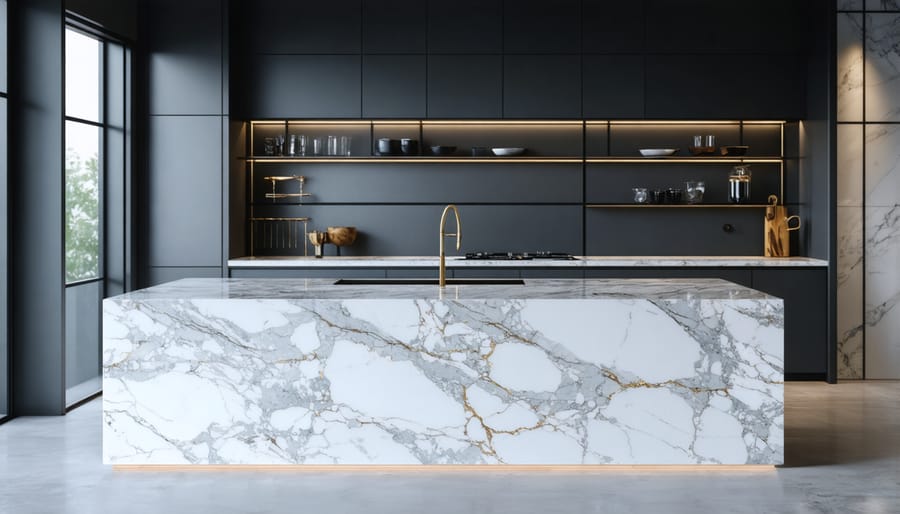
Dark and Bold Colors
Dark and bold quartz countertops make a powerful statement in any kitchen or bathroom design. Black quartz options, ranging from pure midnight black to softer charcoal tones, create sophisticated spaces that exude luxury and drama. These deep hues effectively hide stains while complementing both modern and traditional design schemes.
Deep blue quartz countertops are gaining popularity, offering a unique alternative to traditional dark stones. Navy and midnight blue variations provide depth and character, especially when paired with lighter cabinetry or metallic fixtures. These bold blues can transform an ordinary kitchen into an extraordinary space.
Other dramatic options include deep emerald greens, rich burgundies, and intense coffee browns. These colors often feature subtle variations and movement patterns that mimic natural stone, adding depth and visual interest to the surface. Many dark quartz options incorporate metallic flecks or veining, creating stunning light-catching effects under different lighting conditions.
When selecting dark quartz, consider the room’s lighting and size. While these bold colors create impressive focal points, they work best in well-lit spaces where their rich tones can be fully appreciated. Pairing dark countertops with lighter elements helps achieve a balanced design that doesn’t overwhelm the space.
Nature-Inspired Hues
Nature-inspired quartz countertops capture the essence of earth’s organic beauty with warm, inviting tones and subtle variations. From sandy beiges and rich browns to deep forest greens and smoky grays, these hues create a harmonious connection with natural elements. Popular choices include creamy travertine-inspired designs, golden wheat patterns, and stone-like textures that mirror riverbed sediments. These earthy colorways offer timeless appeal while providing the durability and low maintenance of engineered quartz. The versatility of nature-inspired tones allows them to complement both traditional and contemporary design schemes, making them an excellent choice for homeowners seeking a balanced blend of sophistication and organic warmth in their living spaces.
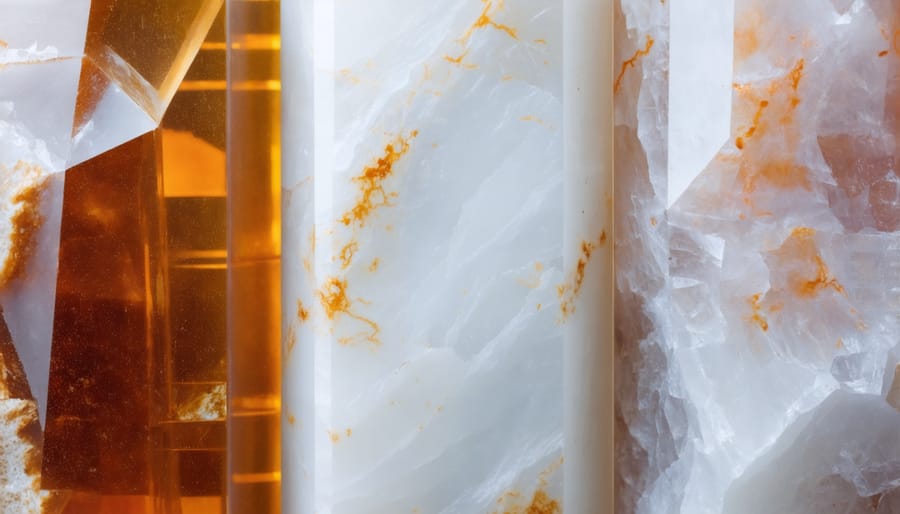
Common Quartz Patterns
Solid and Minimal Patterns
For those seeking a refined, contemporary aesthetic, solid and minimal patterns in quartz countertops offer timeless appeal. These designs range from pure, uniform colors to surfaces with subtle variations that mimic the gentle movement found in natural materials. Popular options include pristine whites, warm greys, and sophisticated blacks, each featuring minimal veining or speckling.
Minimal patterns work exceptionally well in modern kitchen designs where clean lines and understated elegance are paramount. These surfaces provide a neutral foundation that won’t compete with other design elements, making them ideal for spaces where cabinets, backsplashes, or architectural details take center stage.
Many manufacturers achieve these subtle looks by carefully controlling the size and distribution of quartz particles and pigments during production. The result is a consistent appearance that maintains visual interest without overwhelming the space. These patterns are particularly favored in commercial settings and contemporary homes where durability meets sophisticated design.
When selecting a minimal pattern, consider how natural and artificial lighting will interact with the surface, as even the most subtle variations can become more pronounced under different lighting conditions.
Veined and Marble-Like Patterns
Modern quartz manufacturing techniques have revolutionized the way we replicate natural stone patterns, offering stunning quartz design options that closely mimic the elegant veining found in marble and other natural stones. These sophisticated patterns feature intricate networks of veins that flow naturally across the surface, creating depth and visual interest that rivals their natural counterparts.
The veining can range from subtle, whisper-thin lines to bold, dramatic streaks in contrasting colors. Popular combinations include white backgrounds with gray or gold veining, reminiscent of Calacatta marble, and cream bases with coffee-colored veins that echo the look of Emperor marble. Some manufacturers even incorporate metallic flecks or crystalline elements to enhance the authentic appearance.
What sets engineered quartz apart is the consistency and control in the veining process. Unlike natural stone, where patterns are unpredictable, quartz manufacturers can create predetermined patterns that maintain visual continuity across slabs. This allows for better book-matching and pattern alignment in larger installations, particularly important for waterfall edges and backsplashes.
The depth and dimensionality of these patterns are achieved through advanced manufacturing processes that layer the veining throughout the material, rather than just on the surface. This creates a more authentic look that maintains its appeal even at the edges and cut-outs of the countertop.
Speckled and Textured Designs
Speckled and textured designs in quartz countertops offer a dynamic appearance that appeals to those seeking visual depth and character in their surfaces. These patterns typically feature small to medium-sized particles dispersed throughout the base color, creating a three-dimensional effect that masks fingerprints and minor scratches effectively.
The speckling can range from fine salt-and-pepper patterns to larger aggregate designs that mimic natural granite. Some variations include multicolored flecks that combine neutral tones like browns, blacks, and grays, while others incorporate metallic particles or recycled glass fragments for additional sparkle and interest.
Textured designs may also feature varied particle sizes within the same slab, creating a more organic, natural appearance. Manufacturers achieve these effects by carefully controlling the size, color, and distribution of quartz crystals and other materials during the manufacturing process. Popular options include designs that simulate the appearance of concrete, with its characteristic aggregate showing, or industrial-inspired patterns that showcase deliberately irregular particle distribution.
For high-traffic areas, speckled patterns prove particularly practical as they help conceal daily wear while maintaining their distinctive appearance over time.
Selecting the Right Color and Pattern
Consider Your Kitchen Style
Your kitchen’s style should be the foundation for selecting the perfect quartz countertop color. Following current countertop trends is important, but ensuring your choice harmonizes with your kitchen’s overall aesthetic is crucial for long-term satisfaction.
For modern kitchens, consider sleek, solid colors like pure whites, deep blacks, or cool grays. These minimalist options complement contemporary cabinetry and hardware while maintaining a clean, sophisticated look. If your kitchen features industrial elements, concrete-look quartz or patterns with subtle flecks can enhance the urban aesthetic.
Traditional kitchens pair beautifully with warm-toned quartz that mimics natural stone. Creamy whites, beiges, and patterns that resemble marble or granite can add timeless elegance without overwhelming the space. For transitional kitchens that blend modern and traditional elements, look for quartz with subtle veining or medium-toned neutrals that bridge both styles.
Farmhouse or rustic kitchens benefit from quartz countertops with more character and movement. Consider options with pronounced veining or patterns that echo natural materials. Earthy tones and textured finishes can complement wooden elements and vintage fixtures while maintaining the durability and practicality that quartz offers.
Remember that your countertop choice should complement rather than compete with other design elements like backsplashes, flooring, and cabinet colors.
Lighting Impact
Lighting plays a crucial role in how quartz countertop colors appear in your space. Natural daylight tends to reveal the true colors and patterns of quartz surfaces most accurately, while artificial lighting can significantly alter their appearance. During morning and afternoon hours, direct sunlight may highlight the sparkle and movement within the material, particularly in designs containing metallic flecks or mirror chips.
Under LED lighting, lighter quartz colors typically appear crisp and bright, while darker shades may seem more subdued. Warm-toned lighting fixtures, such as traditional incandescent bulbs, can add a yellowish cast to white and cream-colored quartz, potentially altering their intended look. Fluorescent lighting might make cool-toned quartz appear slightly bluish or harsh.
Before finalizing your quartz selection, it’s essential to view samples in your actual space under different lighting conditions throughout the day. Consider how your kitchen’s lighting scheme – including under-cabinet lights, pendant fixtures, and natural light sources – will interact with your chosen quartz color. This approach helps ensure the final appearance aligns with your design vision and prevents any unexpected color variations once installed.
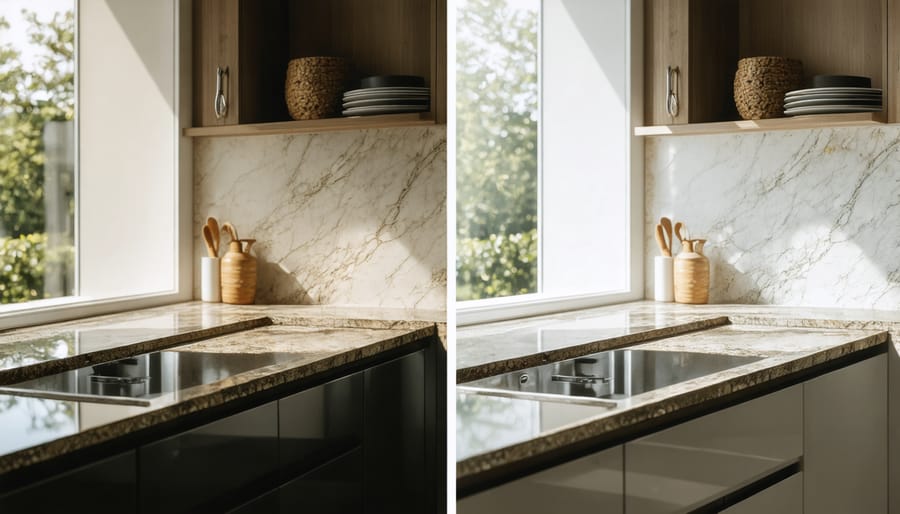
Complementing Cabinet Colors
Selecting the right quartz countertop color requires careful consideration of your cabinetry, as these two elements will share the spotlight in your kitchen design. For lighter cabinet finishes like white or cream, consider dark quartz countertops in charcoal, navy, or deep brown to create striking contrast. Alternatively, pair them with subtle whites or beiges for a clean, cohesive look.
Dark cabinets work beautifully with light quartz countertops, creating a balanced aesthetic that prevents the space from feeling too heavy. White or cream quartz can brighten the room while providing an elegant contrast. For wood-toned cabinets, focus on quartz colors that complement the wood’s undertones. Warm woods pair well with beige or cream quartz, while cooler-toned woods match nicely with gray or white options.
When working with colored cabinets, opt for neutral quartz countertops that won’t compete for attention. Gray, white, or beige quartz can anchor bold cabinet choices while maintaining visual harmony. For two-toned kitchen designs, choose a quartz color that bridges both cabinet finishes, creating a unified look throughout the space.
Consider the veining or patterns in your chosen quartz when matching with cabinets. Subtle patterns work well with detailed cabinet designs, while bold veining can complement simple cabinet styles. Remember that lighting can significantly impact how your quartz and cabinet colors interact, so always view samples in your actual space before making a final decision.
Long-Term Design Considerations
When selecting quartz countertop colors, consider the long-term implications of your choice. While trendy colors might be appealing now, they could potentially date your kitchen within a few years. Neutral tones like whites, grays, and beiges have proven to be timeless choices that maintain their appeal across decades and design trends.
Resale value is another crucial factor to consider. Real estate experts consistently note that classic, versatile colors tend to yield better returns on investment. Bold or unique patterns might limit your home’s marketability, while subtle, natural-looking patterns typically appeal to a broader range of potential buyers.
The durability and ease of maintaining quartz surfaces make them an excellent long-term investment, but their initial cost can be significant. When evaluating quartz countertop pricing, remember that choosing a timeless color and pattern can help ensure your investment remains valuable for years to come. Consider how your chosen color will coordinate with various cabinet colors and wall treatments, allowing for future design updates without necessitating a complete countertop replacement.
Selecting the perfect quartz countertop color and pattern is a significant decision that can dramatically impact your space’s overall aesthetic and functionality. Throughout this guide, we’ve explored the diverse range of options available, from classic neutrals to bold statement pieces, and from subtle veining to dramatic patterns that mirror natural stone.
Remember that the ideal quartz color choice should balance several key factors: your space’s existing design elements, lighting conditions, cabinet colors, and your long-term style preferences. Neutral tones like whites, grays, and beiges offer timeless appeal and versatility, while darker hues and bold patterns can create striking focal points in your kitchen or bathroom.
When making your final selection, consider these essential takeaways:
Test samples in your actual space under different lighting conditions to ensure the color and pattern maintain their appeal throughout the day. Take time to view larger samples when possible, as small swatches may not fully represent the overall pattern and movement.
Consider the practical aspects of your choice – lighter colors show more crumbs and require more frequent cleaning, while darker colors may show water spots and fingerprints more readily. Medium-toned options often provide the best balance of style and maintenance.
Don’t forget to factor in your home’s resale value. While personal preference is important, selecting widely appealing colors and patterns can enhance your property’s marketability. Classic white and neutral quartz countertops consistently rank among the most desirable options for potential buyers.
Finally, work with reputable manufacturers and installers who can provide detailed information about their products’ color consistency and pattern variation. This ensures your finished countertop meets your expectations and maintains its beauty for years to come.
By carefully considering these factors and taking time with your selection process, you’ll be well-equipped to choose a quartz countertop color and pattern that enhances your space while meeting your practical needs and aesthetic preferences.

